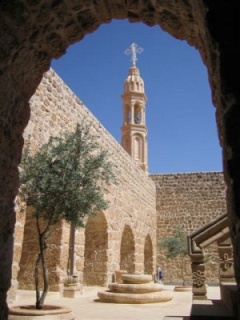Turkish Syriacs lament problems with education, Mor Gabriel
VERCİHAN ZİFLİOĞLU
ISTANBUL – Hürriyet Daily News
4/4/2011
Syriacs in Turkey are fighting to regain their rite to educate their children in their own language, which is recognized by UNESCO as being in danger of extinction. At the same time, many Syriacs are hoping to stop a land grab against the community’s most symbolic center in the country, the 1,700-year-old Mor Gabriel Monastery in Mardin
Turkey’s dwindling number of Syriacs are caught in bureaucratic limbo and are unable to adequately teach their children either their language or their religion, according to members of the community.
“We need a school,” Şabo Boyacı, a leading figure of the Assyrian community and editor of www.suryaniler.com, recently told the Hürriyet Daily News & Economic Review. “But even if we are allowed to have one, we would face difficulties in education because it is almost impossible to have a teacher fluent in Syriac to teach adequately.”
The last Syriac school closed its doors in 1938. “Until the late 1980s, we were going to Armenian and Greek minority schools. But there was a complaint issued, it resulted in a state inquiry and we were deprived of this right,” said Boyacı.
Turkey does not recognize the 15,000-strong Christian Syriacs as a minority, unlike the Greek Orthodox, Armenians and Jews, each of whom is permitted to maintain their own school systems; as such, many from the community attend public schools, especially in Istanbul. Nonetheless, because they are Christians, they are exempted from mandatory religious classes, like the recognized minorities.
This exemption at public schools, however, creates problems for some Syriac children.
“Because [my daughter] is a Christian, she is exempted from the religious courses, but this makes her feel like the ‘other,’” Mesopotamia Culture and Solidarity Association board member Tuma Özdemir told the Daily News. “She should have education in line with her beliefs. Once when she asked me, ‘Why we are not converting to Islam and becoming part of the whole?’ I was deeply saddened. Our children go to the elderly in order to learn one or two hymns. We have only one church in Istanbul and we cannot even raise our own men of religion.”
“We have not only been deprived of our education right,” Boyacı said, adding that they also faced problems with religious complexes in Southeast Anatolia, primarily the 1,700-year-old Deyrulumur, or Mor Gabriel Monastery, in the town of Midyat, Mardin. “We want Mor Gabriel back.”
‘Don’t touch Mor Gabriel’
The villages of Yayvantepe, Çandarlı and Eğlence sued the monastery in 2008 for allegedly occupying their fields. The lawsuit is still continuing.
Noting that the field encircling the monastery has been empty for 10 years and that they had continued to pay taxes on it in full, Boyacı said: “We had to migrate. So, we didn’t pay attention to either the monastery or the field. This is not fair; we didn’t migrate voluntarily.”
A signature campaign at www.morgabrieledokunma.com (Don’t touch Mor Gabriel) is demanding an end to the attempts by local power brokers to take over the monastery’s lands. Some 8,000 signatures have been collected so far, Boyacı said.
Three migration waves
According to Boyacı, Syriacs experienced three different waves of migration, the first of which was in the early 1900, the second in the 1960s and the third in the 1990s. Before the migration waves, there were 200,000 Syriacs living in the region, primarily in the southeastern province of Mardin.
The last wave of migration occurred during the worst days of the conflict in the southeast in the 1990s, Boyaci said. “The Kurdish question hit a peak in the 1990s. We were stuck between the state and the PKK [outlawed Kurdistan Workers’ Party]. Many murders by unknown perpetrators were committed. That’s why we migrated en masse.”
While 15,000 Syriacs are estimated to remain in Turkey – either in Mardin, its environs and Istanbul – the number is actually much higher, he said.
“The figure 15,000 reflects the records kept for those who attend church services. But these are not healthy numbers because there are Assyrians who are not linked with the church,” Boyacı said.
There are also many more Syriacs overseas, Özdemir said, adding that the biggest groups live in India and Sweden. “There are 3 million Syriacs in India today and 100,000 in Sweden. The rest are spread around the world.”


81201 805273Outstanding read, I just passed this onto a friend who was performing some research on that. And he actually bought me lunch since I identified it for him smile So let me rephrase that: Thank you for lunch! 555726